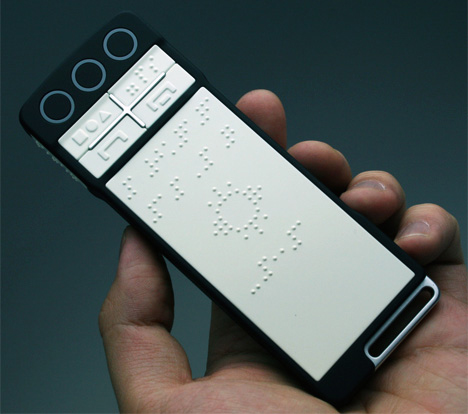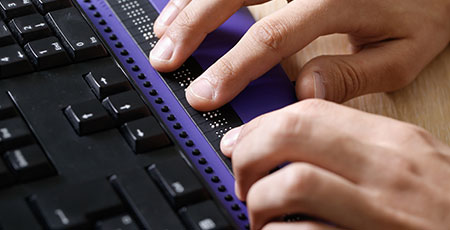Discover Innovative Devices Created for the Aesthetically Damaged
The development of ingenious tools for the aesthetically impaired represents a considerable development in access and freedom. Technologies such as smart glasses with AI capacities and mobile applications designed to provide auditory descriptions are reshaping daily experiences for customers. Furthermore, wearable devices that utilize haptic feedback enhance environmental awareness, while modern Braille innovations supply brand-new ways to involve with message. As these devices continue to progress, their effect on the lives of those with aesthetic disabilities elevates crucial questions regarding the future of inclusivity and freedom in numerous elements of life. What exists in advance in this technical landscape?
Smart Glasses for Navigation

Smart glasses made for navigation are reinventing the way visually damaged individuals communicate with their atmosphere. These sophisticated tools use a combination of camera innovation, synthetic knowledge, and auditory feedback to supply real-time info regarding environments. By employing challenge detection systems, wise glasses can signal individuals to potential hazards, making it possible for much safer wheelchair in both acquainted and strange setups.
The combination of GPS modern technology even more improves navigating abilities, permitting users to get auditory directions as they relocate. This hands-free method not just promotes independence yet additionally encourages aesthetically damaged individuals to browse metropolitan landscapes with increased self-confidence. In addition, many smart glasses are furnished with features that determine spots and street signs, giving contextual information that enhances the individual experience.
Furthermore, the advancement of these gadgets is continuously advancing, with companies functioning to enhance the accuracy of object acknowledgment and expand the variety of navigational attributes. As smart glasses end up being a lot more budget friendly and available, they hold the prospective to substantially transform day-to-day live for visually impaired users. Eventually, these cutting-edge devices represent a crucial step towards inclusivity, offering boosted wheelchair and a greater feeling of freedom for people navigating the world around them.

Mobile Apps for Daily Living
How can mobile applications improve the everyday lives of aesthetically damaged people? Mobile apps are revolutionizing the way aesthetically damaged users browse their atmospheres, take care of day-to-day jobs, and access details. These applications provide important assistance via various performances, promoting self-reliance and enhancing high quality of life.
Several cutting-edge mobile applications are developed specifically for daily living. Apps like Be My Eyes connect visually damaged users with sighted volunteers through video clip telephone calls, enabling them to obtain real-time assistance with tasks such as reviewing tags or browsing unknown rooms. Likewise, Seeing AI, created by Microsoft, makes use of synthetic intelligence to describe environments, checked out text, and identify objects, effectively transforming a mobile phone right into a powerful tool for daily assistance.
In addition, navigating apps customized for the visually damaged, such as Aira and BlindSquare, use audio-based directions and environmental info, enabling users to traverse their surroundings safely and with confidence. Beyond navigation and prompt assistance, mobile apps likewise sustain company and task administration, with features that help users establish pointers, produce to-do checklists, and track consultations. In recap, mobile applications function as essential resources, equipping aesthetically impaired people to lead more independent and satisfying lives.
Wearable Technologies for Assistance
Empowerment through technology is increasingly apparent in the realm of wearable gadgets created to aid aesthetically damaged individuals. These innovative tools incorporate perfectly into every day life, enhancing navigation and supplying essential responses to individuals. For example, smart glasses my blog equipped with video cameras can review and identify faces message out loud, allowing individuals to engage more confidently in specialist and social settings.
Another significant innovation is making use of haptic responses systems in wearable devices. These systems use resonances or various other responsive signals to convey details regarding the customer's atmosphere, such as obstacles or adjustments in surface, enhancing flexibility and security. Wearable innovations likewise consist of wristbands that link to smartphones, notifying customers to notices via subtle vibrations, thus boosting connectivity without dependence on visual cues.
As these modern technologies remain to progress, they are not just improving freedom for visually damaged people but likewise cultivating a greater feeling of addition in culture. By connecting the gap in between obstacles dealt with in day-to-day living and the potential for autonomy, wearable technologies function as crucial devices in the quest for equal rights and empowerment for those with aesthetic problems.
Audio Description Devices
Sound description tools play a crucial function in improving availability for aesthetically impaired individuals, offering them with the ability to involve with aesthetic media. Assistive technology for the click here for more blind. These tools provide narrated descriptions of vital visual components in movies, tv shows, and live performances, guaranteeing that users can completely understand the context and feelings conveyed through visuals
Audio summary can be incorporated into different systems, consisting of streaming services, movie theater testings, and live movie theater. Many popular streaming services now include audio summary as an access attribute, enabling viewers to pick it easily. In addition to conventional media, specialized applications also exist, offering audio summaries for art events, galleries, and various other cultural occasions.
The efficiency of audio description rests on the skill of the storytellers, that have to communicate aesthetic details succinctly without interfering with the initial sound. Technologies in this field are likewise leading the way for more customized experiences, where customers can readjust the level of detail and pacing according to their preferences.
Braille Innovations and Instruments
Braille developments and gadgets have actually dramatically transformed the method visually damaged individuals connect with text and info. Modern innovations have led to the advancement of functional tools that boost article source proficiency and self-reliance amongst users.
In addition, mobile Braille notetakers incorporate traditional Braille input with contemporary performances, promoting note-taking, organizing, and file modifying on the go. Screen readers for the blind. These compact tools often feature text-to-speech capabilities, linking the void in between Braille and auditory information
In addition, innovative Braille printers have arised, enabling individuals to produce Braille labels, records, and academic materials successfully. This accessibility cultivates greater involvement in professional and academic atmospheres, ultimately advertising inclusivity.
In addition, research study into wise Braille innovations remains to expand. Instruments that incorporate artificial intelligence are being discovered to provide real-time navigating help and contextual information, enhancing the individual experience in diverse settings. In general, these technologies reflect a dedication to encouraging aesthetically damaged individuals via technology, guaranteeing they can conveniently accessibility and engage with the world around them.

Conclusion
The innovation of innovative tools for the aesthetically impaired significantly boosts self-reliance and high quality of life. Smart glasses, mobile applications, wearable technologies, audio summary devices, and Braille innovations collectively empower individuals by supplying necessary navigating help, ecological understanding, and enhanced analysis experiences. These innovations not only foster better inclusion however additionally promote freedom in everyday tasks, ultimately contributing to a more equitable and available culture for aesthetically impaired people. Proceeded advancement in this field holds promise for additional enhancements.
As clever glasses end up being much more accessible and affordable, they hold the potential to considerably transform everyday life for aesthetically damaged users. Mobile applications are reinventing the way visually damaged customers browse their environments, take care of daily tasks, and accessibility information. Applications like Be My Eyes attach visually damaged users with sighted volunteers via video telephone calls, permitting them to receive real-time support with jobs such as checking out tags or browsing strange areas.Additionally, navigation apps customized for the visually damaged, such as Aira and BlindSquare, supply audio-based directions and environmental info, allowing users to traverse their surroundings securely and with confidence.The improvement of innovative tools for the aesthetically impaired dramatically enhances self-reliance and quality of life.